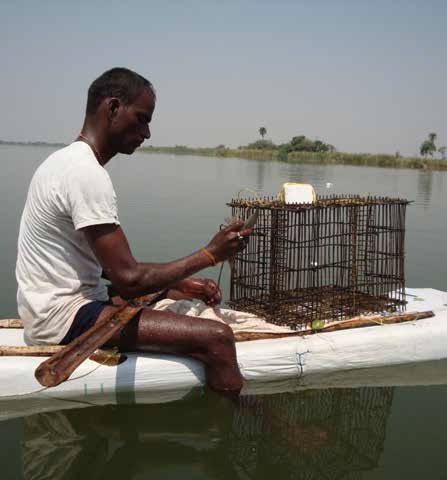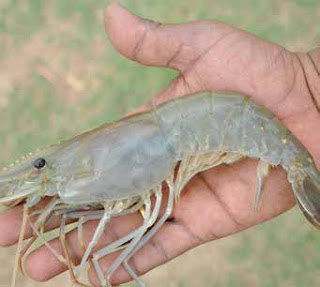First publlished in International Aquafeed, May-June 2015
Reservoirs are the large water bodies and potential source for the development of fisheries in India. In many of the reservoirs, cultivable fishes are being stocked to enhance production. Culture of freshwater prawn, Macrobrachium malcolmsonii along with carps has been carried out successfully in some reservoirs of Telangana since the start of the last decade in India. Ramanpad reservoir is one of them for freshwater prawn culture.
Ramanpad is one of the medium size irrigation projects in the Telangana area. It has 305 hectares water spread area and was constructed in 1972 across Peddavagu, which is the tributary of river Krishna. It is located at Ramanpad village, Kothakota Mandal of Mahabubnagar district in Telangana. It is about 145 Kilometres away from Hyderabad city. The main purpose of the construction of this reservoir was to protect the economically backward areas of the district and also to eliminate the scarcity of food grains and water problems. Though the Ramanpad Reservoir was constructed primarily for irrigation and later became the major supply of drinking water to Mahabubnagar town including many villages in the district, fishery has evolved as the secondary activity.
Every water body has its unique pattern of craft and gear. It also gives indication about the economic condition of the fishermen community where they use locally available, less costly materials to make substances of technological delight giving maximum return. In case of the reservoirs, details about gears used in prawn catching varies from reservoir to reservoir.
Freshwater prawn has become an important component of global aquaculture both in terms of quantity and value. The fishermen of Ramanpad reservoir made attempts and stocked freshwater prawn seed of natural collection from Godavari River in Andhra Pradesh during 2004. Seed grew well and good production of prawn ensued. This encouraged the fishermen, resulting in regular stocking of seed in July and August and allowed them to grow on natural feed in the reservoir up to February. This was the turning point for these reservoir fishermen to get additional income from prawn in addition to regular fish catching.
Catching of prawn from the reservoirs is difficult due to the vastness of the area and great depth. In the first year fishermen used gill nets for prawn catching and faced many difficulties while catching of prawn due to full water level and great depth of the reservoir. Later the fishermen learnt to use the rectangular framed box traps for prawn catching. Since 2005 onwards they have been using indigenous made box traps to catch prawn in the reservoir besides using gill nets and cast nets. The gear used for fish catching is gill nets and for prawn catching box traps along with small mesh size gill nets and cast nets.
Indigenous Gear: Box trap
Among different fishing gears, box trap was one of the major gears used in prawn fishery in Ramanpad reservoir. Box trap was a cube shaped trap made of bamboo sticks knitted with some durable creepers. A bicuspid non-returning uni-directional vertical valve along the height of the trap was made to be used as an entrance for the prawns. The sticks used to make this valve were thinner and knitted with nylon rope. The trap was kept in vertical position under the water. A float made of thermocol/cork was tied with the trap with rope to help in locating the place of the trap.
Benefits of Box traps
The rectangular framed box traps (length 1.75 by height 1.5 by width 1.5 feet size) are made of splinter sticks of bamboos. These traps consist of only one-way entrance slits from both opposite sides and there is no way from inner to outside. These entrance slits allow organisms to enter inside and closes sticks automatically. These traps are cheap and made with locally available materials. Each trap costs about 150 Rupees, which is roughly three US Dollars and durability is about three-four months for regular use in the water. About 80 percent of prawn catching is with the help of box traps only and the remaining 20 percent is carried out with cast nets and gill nets in the reservoir.
Indigenous Technology
Fishermen are engaging in prawn catching activity regularly in the reservoir with box traps. Each fisherman uses 50-60 traps every day to catch prawn in the reservoir. These traps are set in the reservoir with floaters for identification round the clock for prawn catch. Generally, dried coconut pieces’ hang to metal wire inside the trap, used as bait to lure the prawns. The prawn enters into these traps from both sides of one-way entrance slits and there is no way to escape from the trap after entering.
In general, one prawn was caught in unit effort but two to three prawns were also observed in the catch of a trap. The fishermen collect the trapped prawn from these traps daily in the early morning and evening. On average, each fisherman can catch about one to three kilograms per day. Though mostly prawns were being caught by it, sometimes other fishes like Notopterus, Etroplus, minor carps etc also enter into the traps.
The fishermen catch the grown prawn continually for three-five months i.e. from February to June every year along with fish catches. The peak prawn catch is from March to May and the minimum is in the months of February and June. But the fish catch continues round the year by fishermen from the vicinity villages except for a few days in the rainy season. The prawns caught from the reservoirs fetch a premium price and are in great demand because of its natural culture and because they are free from any fertilisers/chemicals. Every year, the fishermen will harvest about 12-14 tonnes of prawn from this reservoir.
Considering the high export potential, the fresh water prawn enjoys immense potential for culture in the reservoirs of Telangana. This achievement is only due to the management practices like good seed stocking, collective harvesting and control of poaching by the reservoir fishermen regularly. Moreover, the uses of indigenously made rectangular traps are more economical and cost effective in prawn catching in reservoirs.
Read the magazine HERE.
The Aquaculturists
This blog is maintained by The Aquaculturists staff and is supported by the
magazine International Aquafeed which is published by Perendale Publishers Ltd
For additional daily news from aquaculture around the world: aquaculture-news






No comments:
Post a Comment